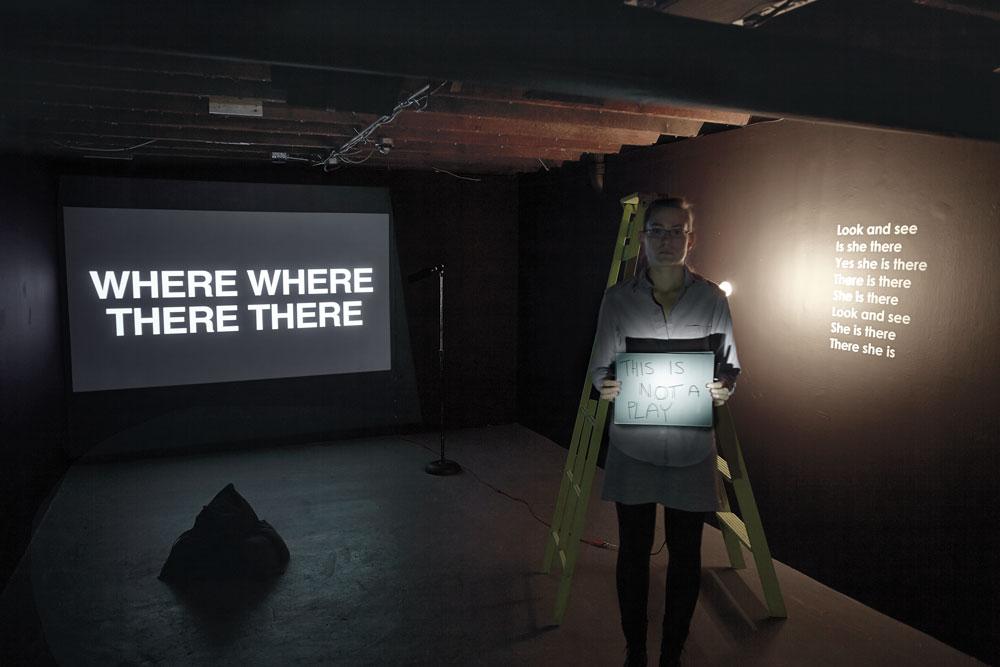Invested in the reconfiguration of performance, Karilynn Ming Ho’s Where Where There There (2012) readdresses a seminal work of theatre by questioning notions of performativity and installation. Taking as her basis Gertrude Stein’s 1938 libretto Doctor Faustus Lights the Lights, the Vancouver artist assembles a re-enactment of this deliberately plotless and at times incomprehensible three-act play. Dummy props and the multiple casting of characters make for a complex arrangement. Like Doctor Faustus, the work does not allow the ease of a stable narrative, or provide a coherent identity for each character.
Drawing on themes found in the original play, Ming Ho structures the organization of her video installation around three acts. She incorporates sections of the original, as well as found and discarded texts from interviews, documentary footage and remade YouTube videos. Acting as a quasi-narrative, this reassembled set of texts operates as a secondary script for Ming Ho, and touches on contemporary themes of viewership and audience in the digital age.
What takes place in Where Where There There is an intentionally naive re-interpretation of Stein’s play. Opening with Three Dog Night’s “One (Is the Loneliest Number),” the work takes the improvisation of three characters as a starting point and moves toward the restaging of singular moments on a theatrical stage, using objects, props and a minimal set. The introduction of these androgynous protagonists is overlaid onto visuals of a hypnotherapy session, as well as scenes of common theatre apparatuses such as mirrors, lights and moveable walls. Act two splices images of roads at twilight and free-falling airplanes with an occasional voice-over, as well as a juxtaposed Werner Herzog monologue from Burden of Dreams (1982). The final section closes with melancholic scenes of a moon reflecting on the water and the act of lighting a cigarette, along with a ballad sung in French by a nondescript chanteuse.
When viewers encounter Where Where There There, the spotlit gallery resembles the theatre set: a ladder obstructs an ideal view, and a microphone stands absently to the right of the room, becoming activated when a character beckons the audience to participate. What results is a complex yet entertaining fragment of acts, with several sections—featuring humorous YouTube-style vignettes—of a writhing contortionist gentleman “for the ladies,” and an enjoyably strange dance scene set to the Carpenters’ cover of “Solitaire.”
Ming Ho reinterprets a generationalized version of Stein’s operatic text, employing many tropes relevant to cinema and theatre, updated through contemporary and often trivialized forms of viewing. At times, the lack of a coherent plot that unfolds between the interaction of characters and objects is only just discernible. Through the installation of theatre objects in the physical space of the gallery, Ming Ho, like Stein, seems to be interested in the aesthetics of surfaces and of formal elements interacting on screen. However, on occasion, the objects are stagnated in the gallery space but similarly stand in for the characters on screen, echoing the obvious lameness present in the act of re-performance. Interestingly, the video installation examines common social tropes that unfold behind and in front of the camera, and are both self-conscious and familiar—all the while addressing the possibilities of the performance of a banal series of events for a contemporary audience.
This is a review from the Spring 2013 issue of Canadian Art. To read more from this issue, please visit its table of contents.

 Karilynn Ming Ho Where Where There There 2012 HD-video projection with sound, ladder, microphone and sandbags Dimensions variable / photo M.N. Hutchinson
Karilynn Ming Ho Where Where There There 2012 HD-video projection with sound, ladder, microphone and sandbags Dimensions variable / photo M.N. Hutchinson







